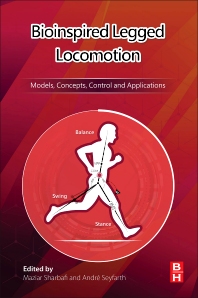
Book preview: New academic study on the subject of robots with legs
Bioinspired Legged Locomotion: Models, Concepts, Control and Applications
By Maziar Sharbafi and André Seyfarth
Elsevier has released a book which may be of interest to roboticists. Here’s a preview.
The book explores the universe of legged robots, bringing in perspectives from engineering, biology, motion science, and medicine to provide a comprehensive overview of the field.
With comprehensive coverage, each chapter brings outlines, and an abstract, introduction, new developments, and a summary.
Beginning with bio-inspired locomotion concepts, the book’s editors present a thorough review of current literature that is followed by a more detailed view of bouncing, swinging, and balancing, the three fundamental sub-functions of locomotion.
This part is closed with a presentation of conceptual models for locomotion.
Next, the book explores bio-inspired body design, discussing the concepts of motion control, stability, efficiency, and robustness.
The morphology of legged robots follows this discussion, including biped and quadruped designs.
Finally, a section on high-level control and applications discusses neuromuscular models, closing the book with examples of applications and discussions of performance, efficiency, and robustness.
At the end, the editors share their perspective on the future directions of each area, presenting state-of-the-art knowledge on the subject using a structured and consistent approach that will help researchers in both academia and industry formulate a better understanding of bioinspired legged robotic locomotion and quickly apply the concepts in research or products.
The book also explores bio-inspired body design and high-level control and applications.
Key content:
- Presents state-of-the-art control approaches with biological relevance
- Provides a thorough understanding of the principles of organization of biological locomotion
- Teaches the organization of complex systems based on low-dimensional motion concepts/control
- Acts as a guideline reference for future robots/assistive devices with legged architecture
- Includes a selective bibliography on the most relevant published articles
Although the book is accessible enough for most people to understand, Elsevier says the target readership for this book is people working in control or mechanical engineering, robotics, biomechanics, as well as corporate researchers in robotics and biorobotics, biomedical engineering.
